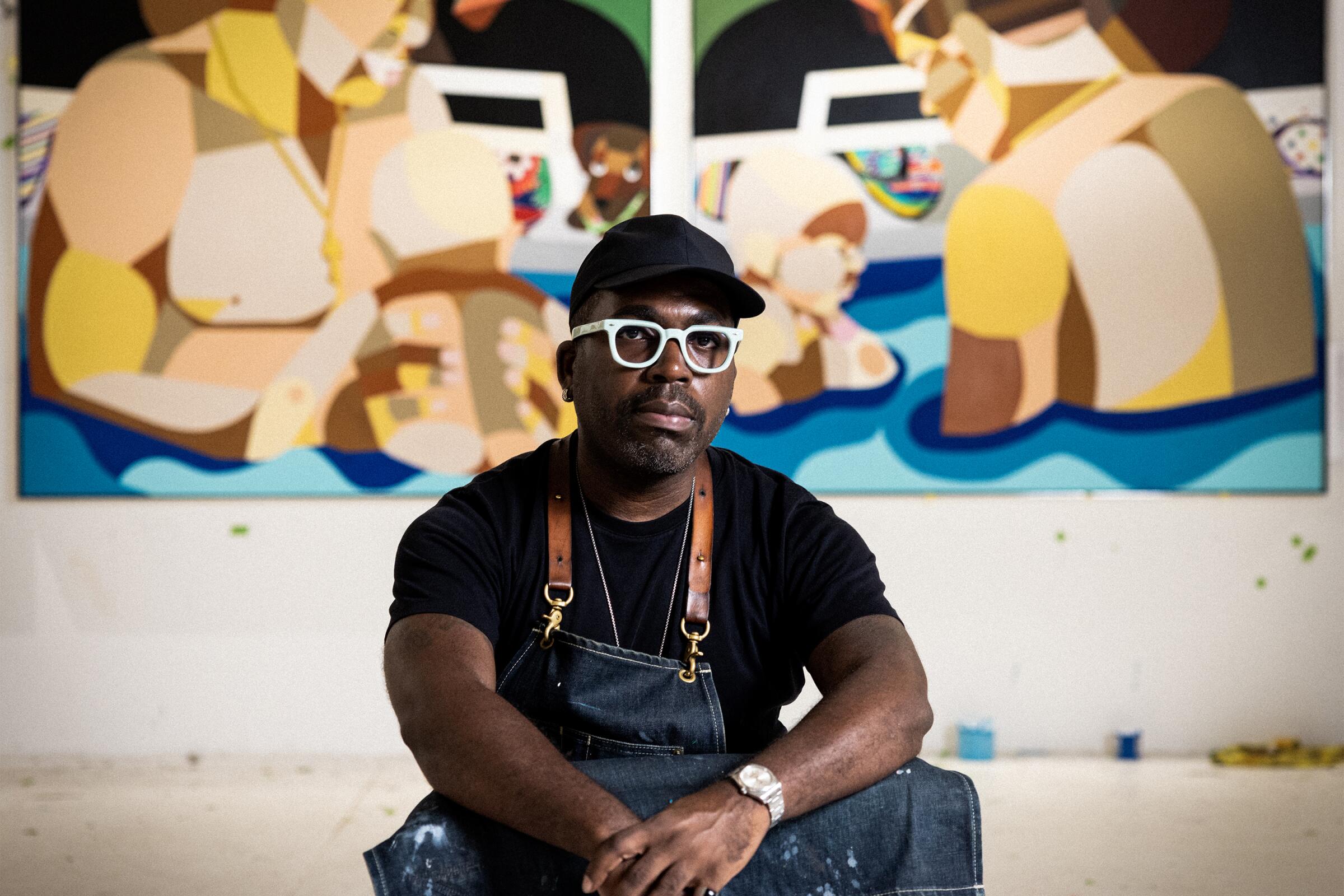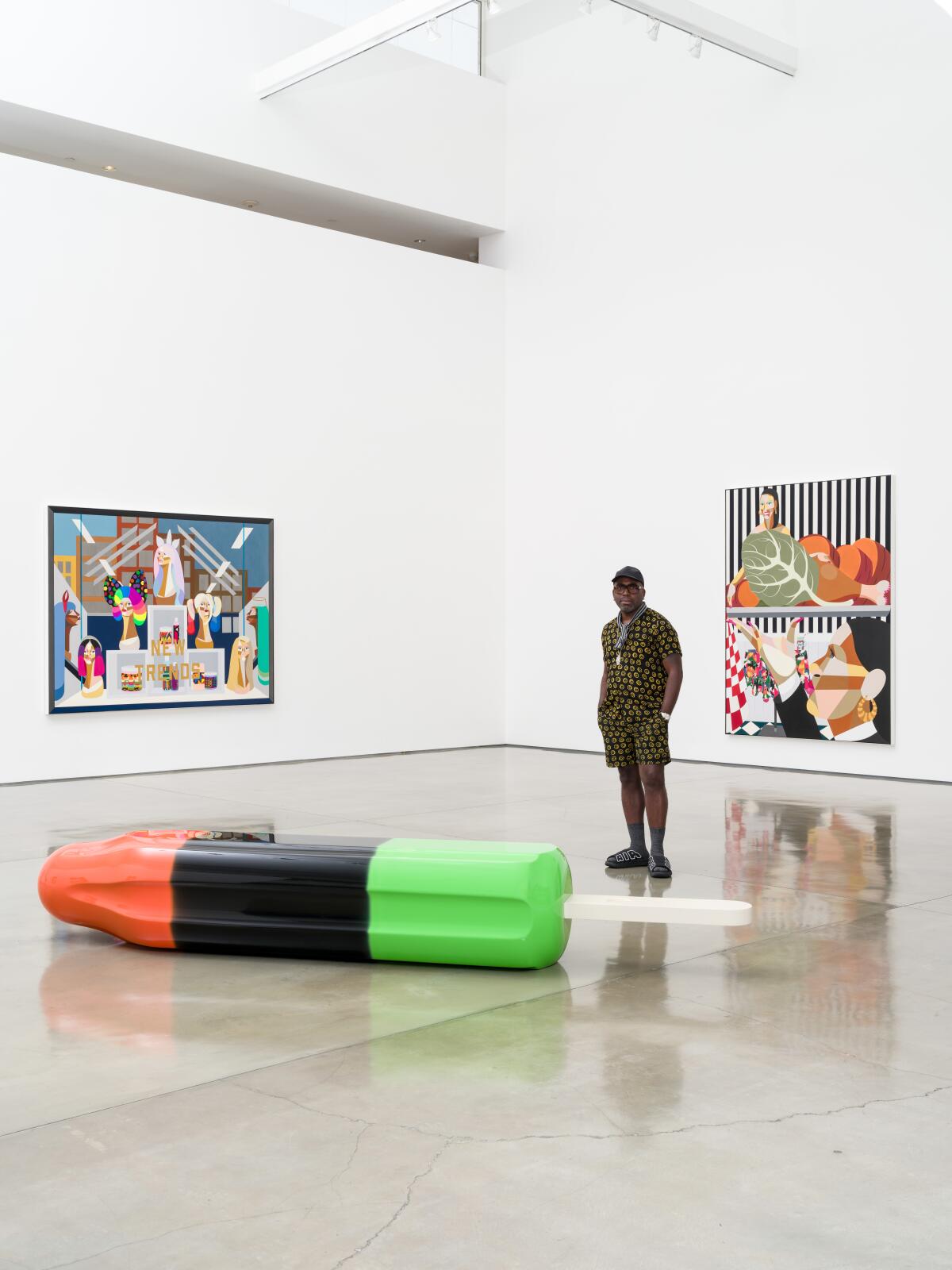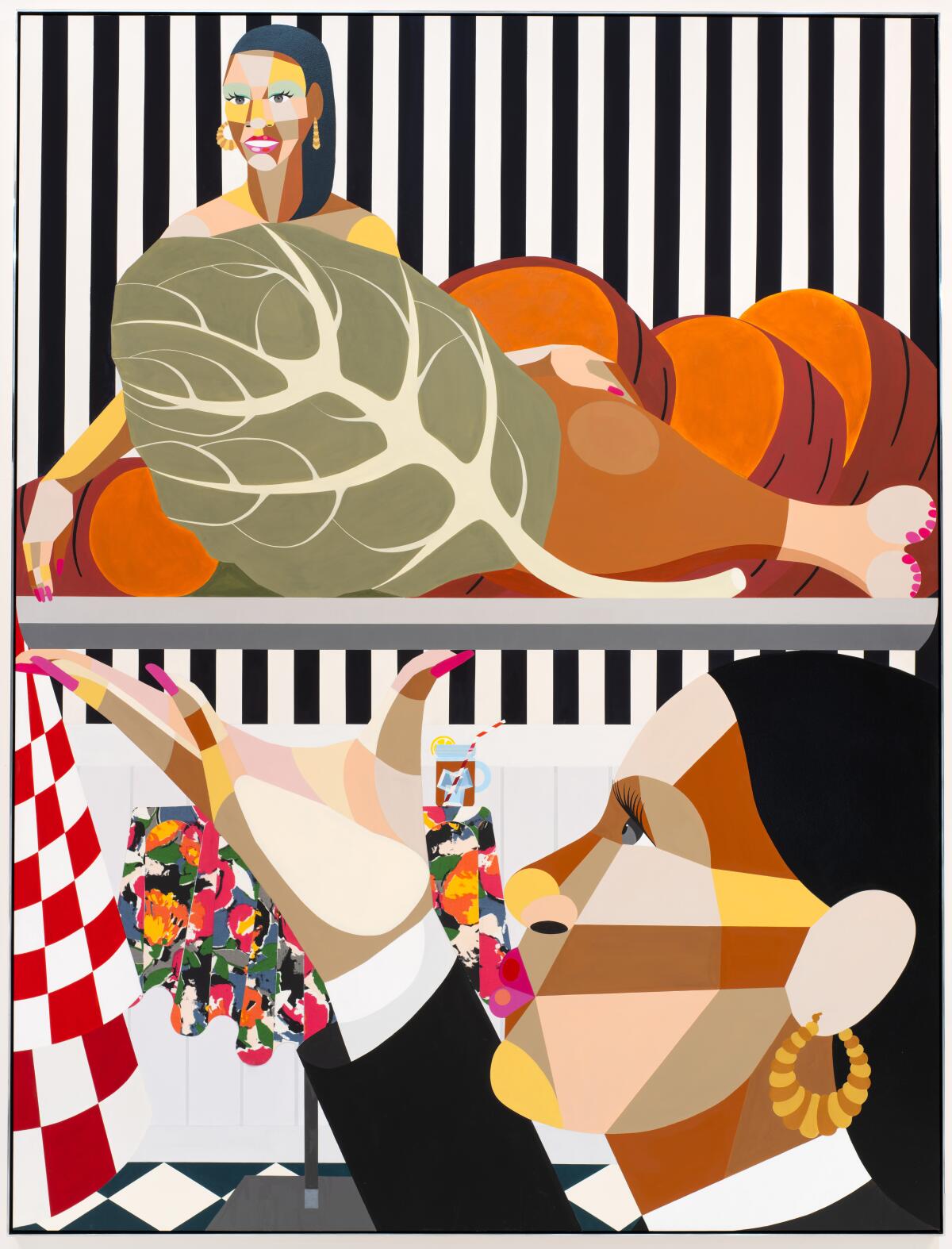The biggest entertainment stories
Get our big stories about Hollywood, film, television, music, arts, culture and more right in your inbox as soon as they publish.
You may occasionally receive promotional content from the Los Angeles Times.

Derrick Adams is serious about leisure. His jubilant, candy-colored paintings depict Black subjects in repose, in the midst of revelry, and surrounded by the creature comforts of home. Whether they’re maxing and relaxing in a bubble bath or soaking up the sun in a pool floater, Adams portrays Black people at ease. Paradoxically, aside from his in-studio yoga breaks, the Brooklyn-based multidisciplinary artist seldom takes time in his own life to rest.
This year alone, he opened the Last Resort Artist Retreat, a residency for Black creatives in his hometown of Baltimore; erected an interactive sculptural installation on the National Mall in Washington, D.C., commemorating the city’s first desegregated playground; and had solo shows in New York, Chicago and Detroit. Adams, who is now represented by the Gagosian gallery, will debut his exhibition “Come as You Are” at Gagosian Beverly Hills on Thursday.
“For a person who depicts leisure in their work,” Adams quipped during a recent Zoom interview, “for me, leisure is working!”
In addition to several newer paintings, the exhibition includes his signature “Funtime Unicorn” sculpture — the artist’s own swaggy spin on traditional playground spring riders — as well as his “Cool Down Benches,” giant fiberglass pieces that riff on Bomb Pops by presenting the iconic ice cream truck treats in the colors of both the American and Pan-African flags.

Altogether, the punchy pieces trigger a warm wave of nostalgia, emanate feel-good vibes and elicit knowing chuckles from viewers who see their own lives and communities reflected before them. But when Adams captures scenes from a family house party, a backyard hangout or father-son playtime, he sees them as more than mere flights of fancy. For African Americans in particular, he views such moments of relaxation as being “terribly important for our mental health.”
“These are things that have sustained us in our society,” he explained. “If we did not have these things — these barbecues and baby showers and christenings — we would be in a very different place than we are right now, and not a place that we would feel good about. In the face of adversity, a lot of these things that we’re doing are really giving us that sense of normalcy.”
We spoke with Adams about putting a premium on Black joy. The following conversation has been edited for length and clarity.
In the past, you’ve said that you consider it “a deliberate political act” to represent the Black experience in a way that “centers the celebratory.” Why do you feel it’s important to do so?
If you think about all the turmoil, struggle, strife and challenges that happen to Black people on a daily basis, you would think that we wouldn’t even have time to even think about this term — Black joy. I look at it deliberately because I feel like Black joy is different because it comes with this other extended history attached to it that may not necessarily be as joyful. It’s something that you have to take. I feel like you have to take this joy. You have to say, “I want to be happy.”
I believe that you can be a part of the protest or be a part of political groups and still make work that is humorous and make people feel empowered or feel normal. For me, art is mine. I have the opportunity to make whatever I want to make. I’m not going to bring certain energies into my studio that are not going to make me feel good. I want to be able to turn the lights on and smile and be excited to get to it.
When I think about bringing humor, imagination, fantasy, normalcy and joy into my work, I feel like those things are so important right now. They are needed in the world for people to have varied options of how to engage with the narrative surrounding the Black experience.

In recent years, we’ve seen the rise of social media phenomena like #BlackBoyJoy specifically focusing on Black males expressing their happiness.
As male figures, we’re taught to be guarded — even more so within Black culture. We have this social construct that you have to walk a certain way, you have to express yourself in a certain way. And now, we have a new generation of millennials, and even Gen Z, who are really emotional and they express themselves and they cry and they tell you how they’re feeling. I teach and I feel emotions when I’m engaging with students that I did not have access to at their age. I think they’re in a different place.
For me as an artist, I get excitement out of seeing how they respond to the things I put out in the world because I think it gives them a sense of empowerment when they walk into a space and are able to laugh, or able to smile, or look at themselves in a position of normalcy.
You also balance the joy with references to history, as with your painting “Be the Table,” which gives a nod to Shirley Chisholm, the first Black woman in Congress, who famously said: “If they don’t give you a seat at the table, bring a folding chair.”
When they see “Be the Table,” people who know that quote will look at it and smile! But that’s what you have to be. You’re no longer trying to get a seat at the table; if you are the table, they’re gonna have to take a seat around you because you’re the center of the whole conversation. Actually, that painting is a reference from a family photograph. When I was growing up in Baltimore, we would have Halloween parties and all of my aunts, cousins and uncles would think of what kinds of costumes they were going to wear. My aunt (in, like, the mid-’80s) came as a table. She took a cardboard box, made a tablecloth, and her head was the centerpiece.
Even when I paint images that are from family photos, I usually pick images that are so absurdly humorous or weird that when people see the painting, they would think it was solely from my imagination. The title “Come as You Are” is really talking about all the different characters that I created in this show that allude to things that are familiar to me but are also so outlandish in the way that they’re portrayed that you have to look at imagination as being an important part of the way we’re able to move through the world. That imagination is part of the power we have.
'Come as You Are'
Where: Gagosian, 456 N. Camden Drive, Beverly Hills
When: 10 a.m.-5:30 p.m.Tuesday through Saturday. Through Oct. 28.
Info: (310) 271-9400, gagosian.com
The biggest entertainment stories
Get our big stories about Hollywood, film, television, music, arts, culture and more right in your inbox as soon as they publish.
You may occasionally receive promotional content from the Los Angeles Times.